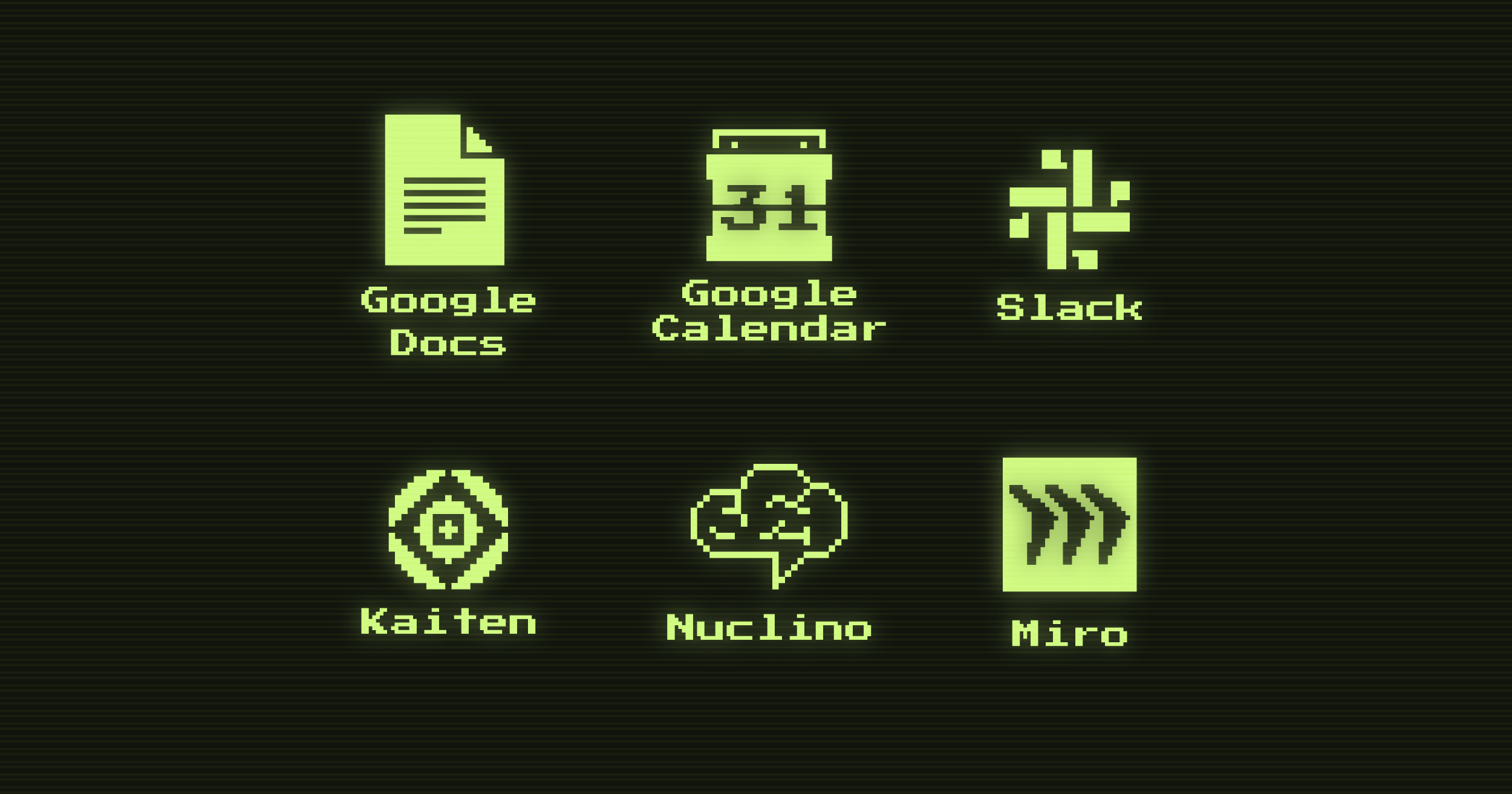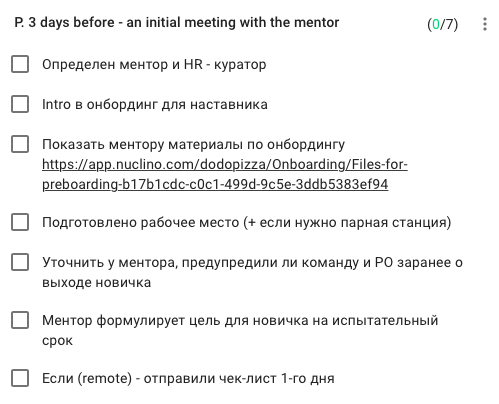

The author of the article: Yana Khodartsevich - Scrum master and onboarding lead at Dodo Pizza.
Several stages of the formation of requirements, hours of interviews and communication with candidates were aimed at finding a certain person with certain qualities and professional skills. At the moment when the company finds a person for an open vacancy, it
Now you need to immerse the newbie in workflows. To do this, you can use one of three chairs:
- Do nothing, let him swim himself. In this situation, a new employee is given a laptop / computer on the first day, shown where the cooler is and escorted to the desktop. And after three months they ask the question: "Well, are all the tasks ready?" Hardcore, but effective, like in Sparta. The most powerful survives.
- . , , , ( « »). , . , .
- , , . . , , .
Until 2017, our company was still located in the Syktyvkar office. At that time we were one big team of developers, technical support, designers, training center and many others. A new person could quickly get to know his team, sitting side-by-side with them, instantly immersed in the project and subject area.
A fat reason to create a process
In 2018-2019, the team experienced explosive growth - in two years we have doubled. Have you heard of the 250 developers goal ? Then we stubbornly took up its implementation, but did not yet know that we were not ready for such a rapid growth. Our approaches and resources to expanding teams quickly became exhausted. In the end, even beginner seats were hard to find. But we did not understand this at once.
People came to the company and somehow settled in the teams, no one really looked after them. In fact, all onboarding consisted of a welcoming package, a friendly greeting, a tour of the office and, perhaps, everything.
We tried to pull the old processes onto a new reality and cracked like a glass glass into which boiling water was poured sharply. Without a single onboarding system, the newcomer's immersion in the team was more like the story of the protagonist in The Survivor. When we looked back, we realized that we had lost many (over 40) new employees.
welcome aboard
Formally, we divide onboarding into 2 streams: for the IT team and for the business unit. They are very similar to each other, and the only difference is in the number of stages and Intro-meetings. In this article I will talk about onboarding for an IT team. You can watch a short video about why you need it at all and what its use is here . Further I share the details.
Characters
In the process of onboarding a beginner, three characters take part: a mentor, an onboarding lead and an hr-curator.

 Mentor.
Mentor.
Purpose : to immerse the newcomer in the team.
Who he is and what he does : The mentor plays a major role in the beginner's onboarding (even if he doesn't know about it). This is a person who helps a beginner in everything. He meets him on the first day and only lets go completely after onboarding is over. Introduces to the team, supports, answers all the questions about why and what for.
A person from the beginner's team can become a mentor. It can be either a person with the same stack, or, for example, an Android developer for a mapi beginner. If a mentor and a beginner have one stack, then they have no choice - they will work in pairs for a very long time. If the mentor and the newbie are from different stacks, there are 2 options:
- Mentor at maximum speed. The mentor and the beginner are ready to work in pairs, the mentor helps with solving problems from different stacks.
- . , . , - senior-, .
 Onboarding lead.
Onboarding lead.
Goal : to control the onboarding process, to make sure everything is moving in the right direction.
Who is he and what he does : An onboarding lead is an organizer of onboarding in IT. To become them, you need materiel skills. It is important that the onboarding lead knows and understands the value of each of the tools in IT, “brewed in this culture”. The main task of an onboarding lead is to make sure that the mentor and the newbie succeed, and highlight the moments that do not work. This role is very similar to that of a police officer. The onboarding lead walks somewhere nearby, looks after the newbie, asks how are things, what is already happening. Provides advice to the mentor in any questions, provides support. In general, he makes sure that everything is as it should be (and as it should not be, it was not).
 HR curator.
HR curator.
Purpose : to provide a newcomer with a pleasant entry into the company from the moment the offer is submitted. Provide all the necessary information from the HR side, which will allow the new employee to navigate the company.
Who is he and what does he do : hr-curator is the one who meets the newcomer on the first day at the office, helps to draw up the documents. Then he interacts at an informal lunch in the middle of the trial period. This is necessary so that a beginner can abstract from onboarding, tools, tasks and communicate on any topic, get support.
Instruments
To make onboarding clear, we chose the following tools to help us: Slack, Kaiten, Google Docs, Nuclino, Miro, Google Calendar.

I'll tell you more about how it all works.
- hr- Slack. (, — ). .
- hr- Kaiten ( Trello). , , , . , .
- Nuclino — , . Nuclino , , .
- Miro . , , . , , .
- . , , Google Calendar. , , Intro.
- In addition to all of the above, the newbie has an assistant Dodo Bot - this is our internal bot that sends the newbie with useful information about the company, for example, how to arrange a vacation or how to book tickets for a conference, etc.
Process: from preboarding to free swimming
The actors and tools have been identified, which means we are ready for three months of active acquaintance between the company and the newcomer. The process consists of 2 stages: preboarding (before going to work) and onboarding.
Preboarding
A newbie comes to work on his first day. Receives equipment, signs documents, meets the mentor and the team. While all the necessary programs are being installed, they go with a mentor to get acquainted with other teams and people with whom they will work together. Everything is going smoothly and with good reason - preboarding.
Pre-boarding starts 3 days before the start. The main goal is to make sure that everyone (mentor, onboarding lead, hr-curator) remembers the release of a new employee and is ready for this moment. Before we had preboarding, there were cases that on the first day a beginner was looking for a place to work in the office. Or even worse - on the first day, a greedy search for a team and a mentor began. Don't repeat our mistakes.
What do we do on preboarding?
- Powder the mentor, tell him what awaits him, show him where all the necessary information lies.
- Preparing a table (not the one you thought of).
- We run through the list again to see if everything is ready.
- In general, active chores.

Preboarding checklist
If something from the list is not ready yet, we have time to fix it.
Active phase of onboarding
Then the active phase begins, in which the circuit helps not to get confused. I will dwell in more detail on its parts and components.

Yellow rectangles are onboarding foci. What the whole process and mentor is focused on and sharpened in a given period of time.
The mentor's focus is built on the theory of Situational Leadership . The mentor, tracking the progress of the beginner in various tasks, regulates his intervention in his life. If he sees that somewhere a beginner is already doing well himself, he minimizes his participation. The first 3-4 weeks the mentor and the beginner practice pair work. In addition, the mentor invites the beginner to all team events and activities. After the middle of onboarding, the mentor locks the newcomer less into himself and more transfers him to the team.
Light green rectangles - Checkpoints.They can also be called reference points, cutoffs. At Checkpoints, an onboarding lead or hr-curator is connected to the onboarding process. This takes place in the format of meetings, at which we ask a newbie about working with a mentor, what happens, where difficulties arise, whether any help or support is needed.

Checkpoint Checklist
Answers to these questions help you understand if the mentor is doing well or needs help. It is important to understand that this is not an exam for either a mentor or a new employee. Rather, it is a source of information for onboarding leads: is everything going well, are there any problems with interaction or feedback, is the newcomer in contact with the mentor and the team. If at the meeting it turns out that there are some problems, onboarding lead helps to solve them.
Why are Checkpoints conducted by onboarding leads and hr curators rather than mentors?
. --, . Checkpoints - . , / .
Final Checkpoint. I would also like to tell you about the final Checkpoint. It is held at the end of the second month of work and includes all the key knowledge that the newbie has gained during this time. The following topics were included in the question checklist:
- Technical skills: knowledge of the system architecture.
- Engineering practices: XP and everyone connected with them.
- Culture: our business, values, their embodiment or violation by examples.
- Processes: Scrum, LeSS, how the feature is formed.
- Overall: onboarding feedback.
The Final Checkpoint is held one month before the end of the trial period. We deliberately make sure that we have time to work on mistakes, if there are difficulties in adaptation.
White stars - Intro. This is what we call expert meetings and workshops. This also includes all introductory meetings where they tell, show and do something interesting that helps the newcomer to get to know the company better.
Each Intro meeting is tailored to its own theme. Purpose: to acquaint the newcomer with the company, its values, processes and business. For example, we have Intro to Dodo Business, Intro to Scrum / LeSS, Intro to culture and principles of leadership.
Basically all Intros are 1-1.5 hours long. But there are a couple of technical workshops that take 2 hours.
Process duration
The duration of onboarding is 3 months and there are a couple of reasons for this:
- A voluminous program that should be correctly dosed so that there is no purely humanitarian or "lecture" week. We decided that it would be impossible to load all the knowledge into a beginner in 2-4 weeks. After all, he needs not only to get them, but also to learn how to use them.
- Smooth entry into the team and processes. In the first month, the beginner gradually understands what is happening around and how we live. From the second to the third, he slowly goes into an independent mode of operation. There is a willingness to take responsibility.
Every company should experiment with timing to find the optimal timing that's right for them. For us (as well as for Yandex, Adventum, Net by Net), onboarding in 3 months seemed the most successful solution.
Completion of onboarding
At the end of onboarding, a final meeting between the mentor and the beginner is held in a 1: 1 format. On it, the guys conduct mini-retro: they discuss what was good in their joint work, what they did not have time or did not do, how much they coped with the goals for the trial period. In general, the mentor and the newbie discuss whatever their heart desires, and put the point of onboarding.
The main difficulties
At every stage of the development of the process, we encountered small difficulties. It seems important to talk about them, because it can save you a lot of time or nerves.
Unreadiness of the process for rapid changes. Initially, our onboarding was only suitable for those working from the office. But at some point, we began to hire remote employees, and then completely went into self-isolation and work from home. Here we have some questions:
- What about Intros, which involve face-to-face participation?
- How to issue a welcomb package? And how not to forget to give it out?
- How to organize work with a mentor: informal communication, pair work, and so on.
There were quite a few such moments, and we were able to solve some of them only now. For example, we have decomposition and user-story mapping workshops that used to involve personal presence. It was not possible to get off with a simple alteration of the presentation. After almost four months of self-isolation, we were able to transfer everything to an online format.
You have to invest a lot in onboarding. We believe that all efforts, money, time and resources are investments in the future. We believe onboarding helps, and people praise it for a reason. “Old people” (employees who have been working in the company for more than two years) even came to us and said that they lacked such a process at one time. It turns out that so far we can only build confidence in the effectiveness and benefits of onboarding through such feedback.
Now we are actively collecting feedback from participants in the process. We will find out how well onboarding suits them, whether it helps, what problems it solves and what it brings. All this helps to understand whether we are moving correctly.
It is this difficulty in assessing performance that can affect whether your company adopts onboarding or not. But if you figure out how to calculate the effectiveness, it will be very cool, come to the comments and write your suggestions.
Takes a lot of time for both the beginner and the mentor. We always warn product owners that in the first 1-1.5 months the team will not have +1 people, but -1. This is due to the active participation of the mentor in the life of the beginner. Success, movement towards goals, immersion in practice, and so on. All this together consumes a lot of the mentor's strength. This fact interferes with product development of the team's features and slows it down.
Business is not always ready to agree to such conditions. Then you have to negotiate to reduce the load on the beginner or mentor. Only discussion and common sense can help in resolving this issue. For example, we had cases where we freed a newbie from some Intros if he himself is well versed in the topic.
Blitz: feedback from participants
, , . -- . , . , .
3 ?
?
, .
3 ?
?
: . .
3 ?
- Intro. . , .
- , , .
- , , .
?
- , . . .
- , , 100500 , .
- .
, .
3 ?
- , , -, , , -, . , . !
- .
?
- . , ( ).
- -.
- . , . , , .
- , , . , - , .
: . .
Conclusion
I just want to say that onboarding, like any experiment or innovation, should be implemented iteratively. First, close the main pains, then add something interesting, and after that you can look for ways to develop something more global. Do not forget to collect feedback on onboarding and its benefits from each newbie. This will prevent your process from hardening and growing overgrown with vines. Remember that it is important to pay attention not only to beginners, but also to mentors, to support and help them.
AND! If something doesn't work in a new mentor-mentor pair, it doesn't mean that one of them is an asshole. Perhaps there is something wrong with the process and somewhere it interferes more than helps.